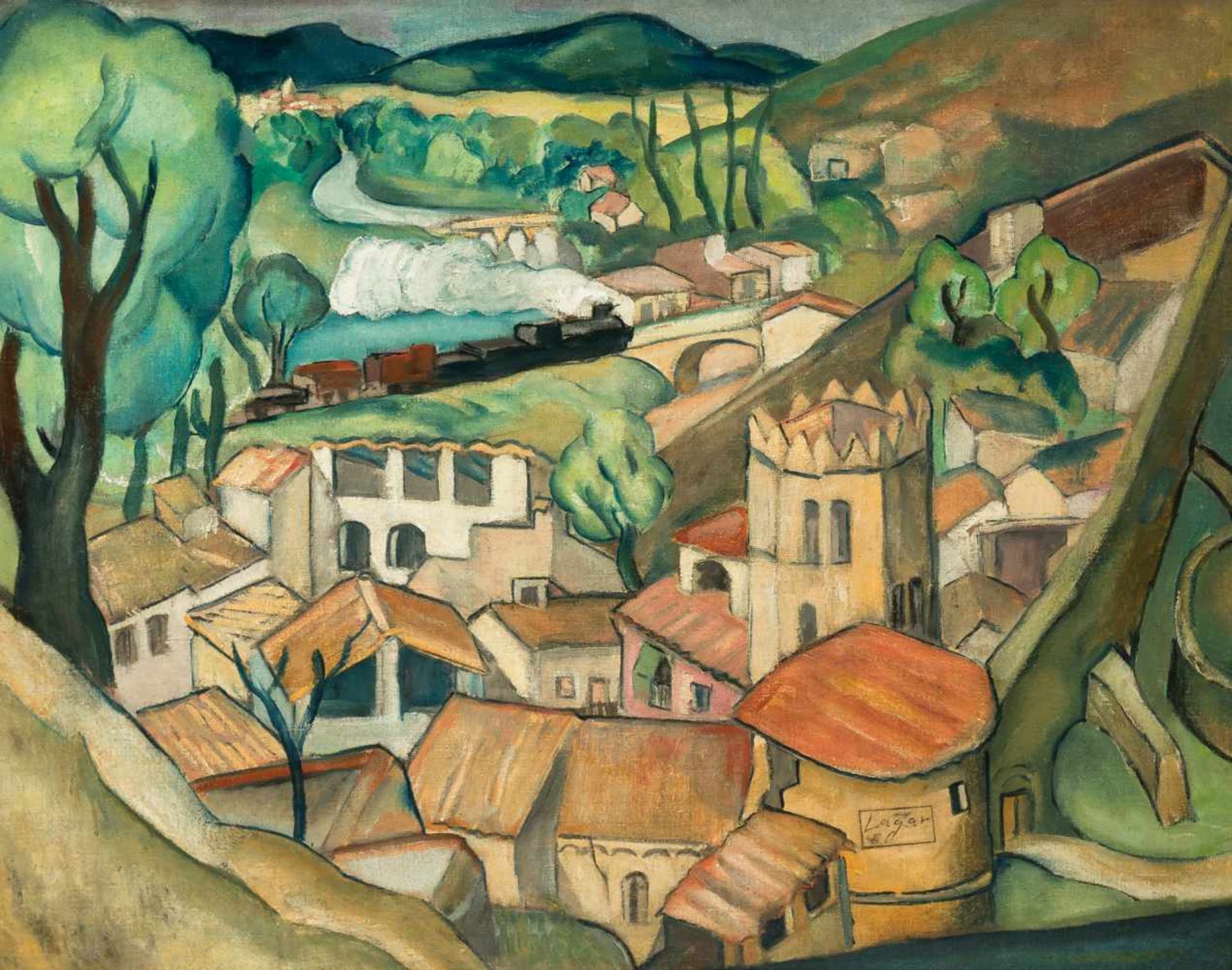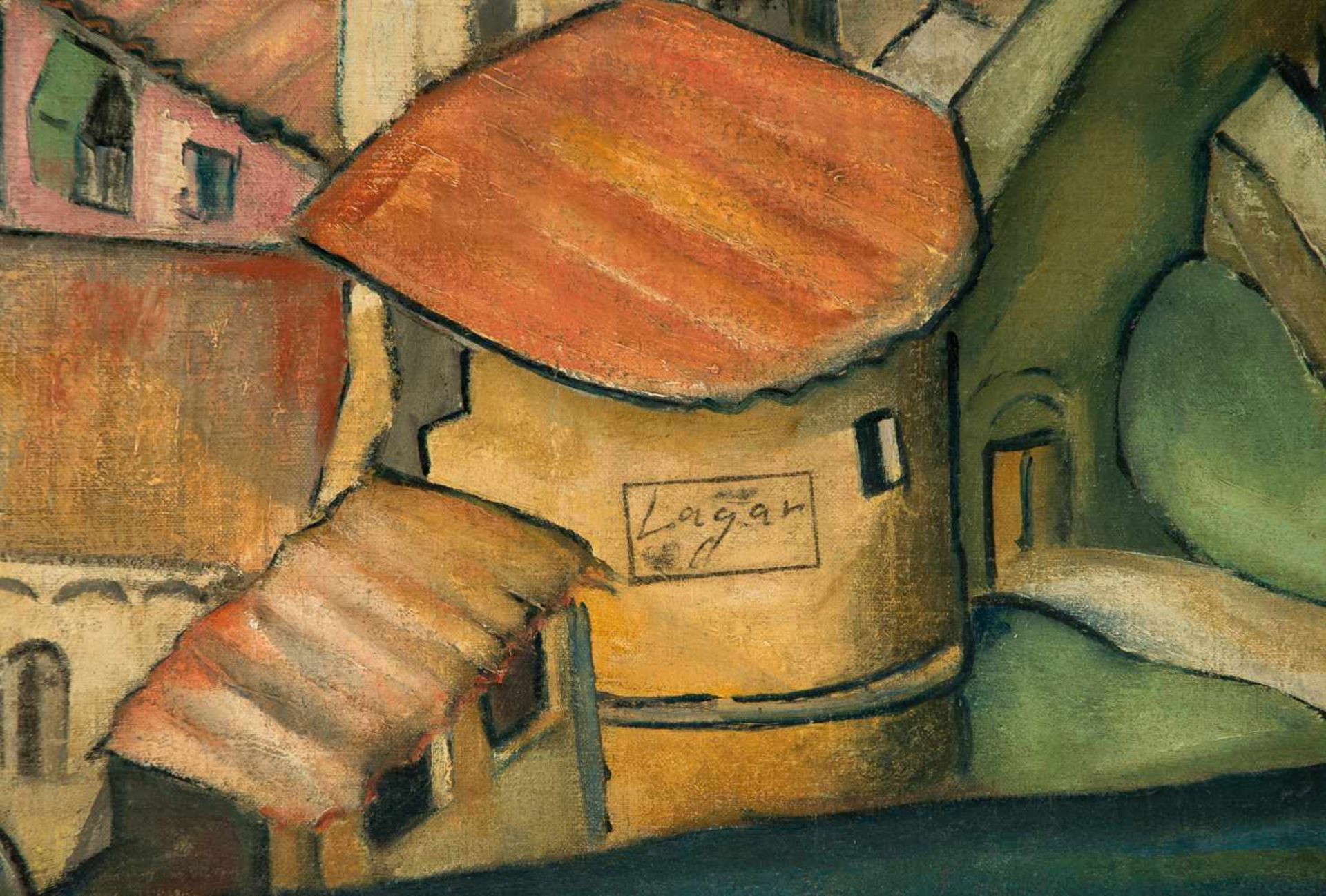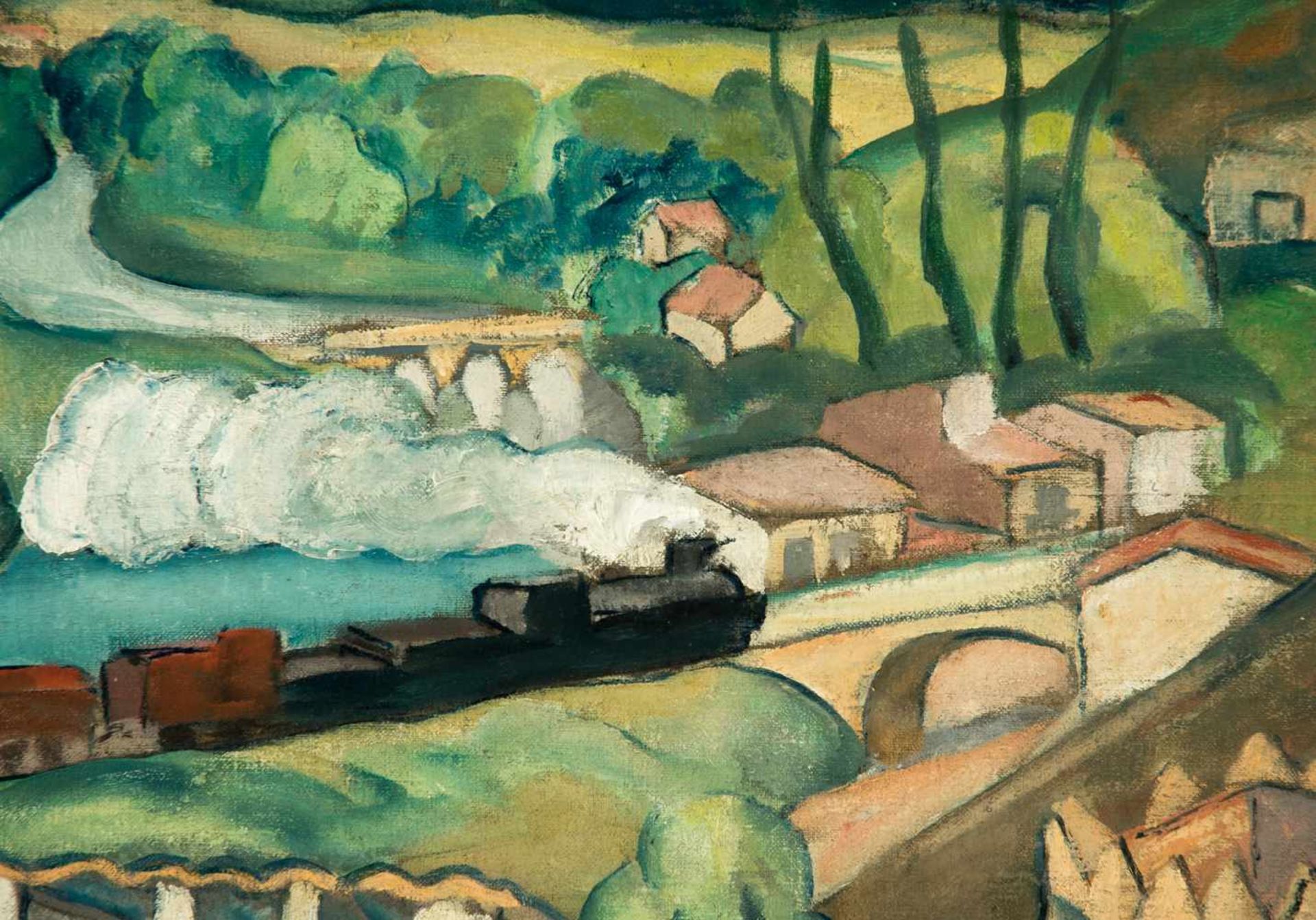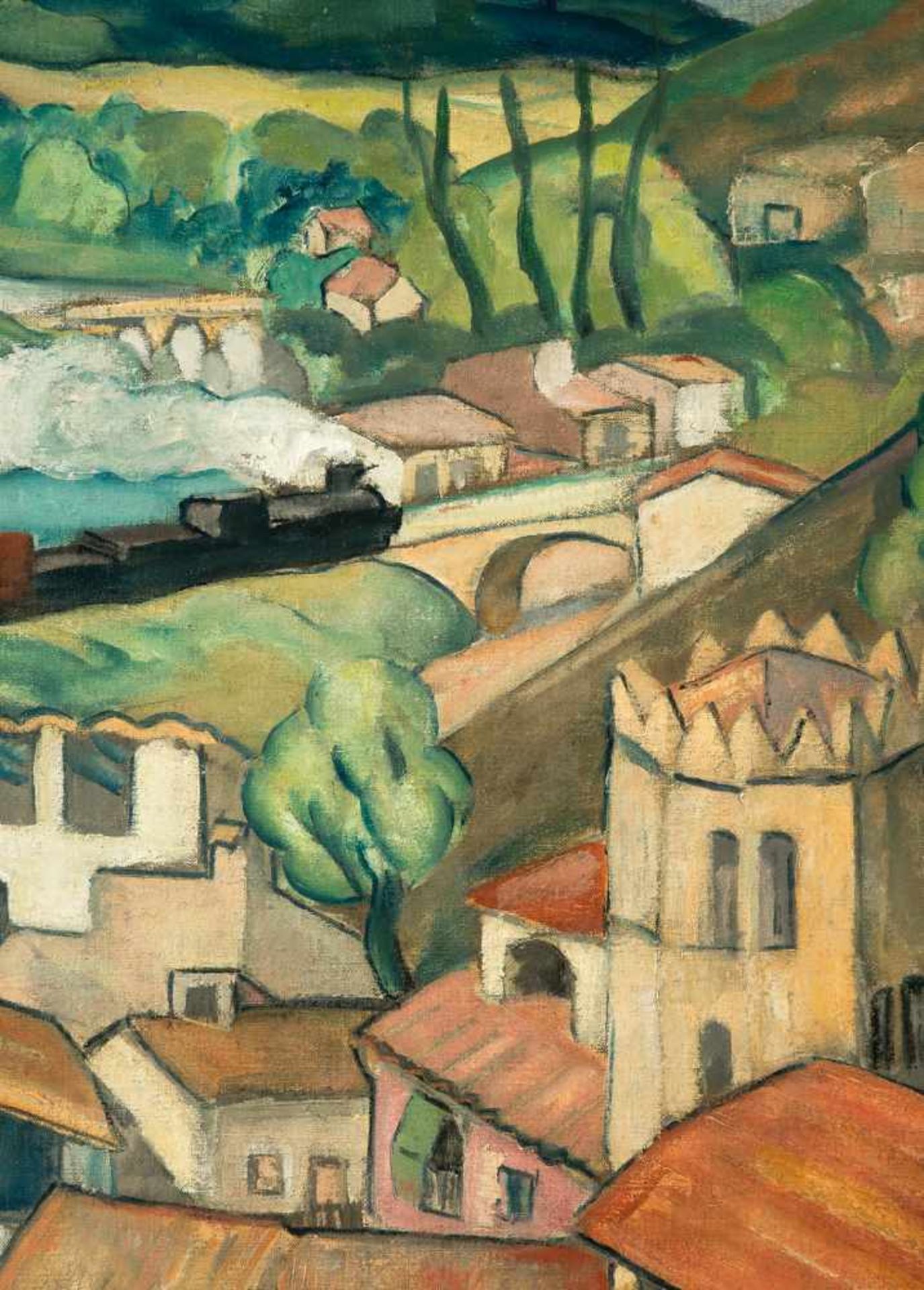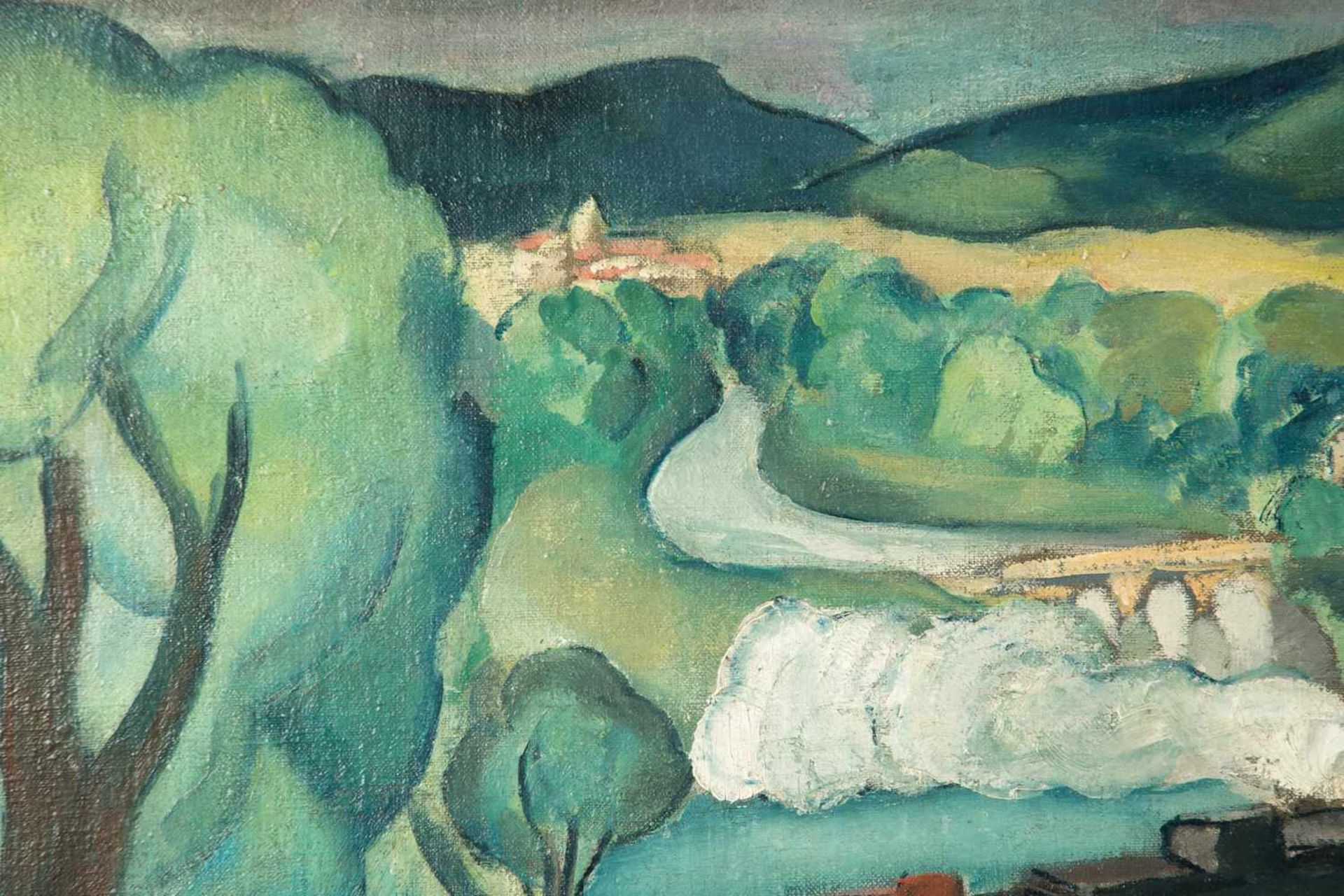35
Celso Lagar (Ciudad Rodrigo, 1891 - Seville, 1966) "Girona. Tower and apse of Sant Pere de
1/5
Das Auktionshaus hat für dieses Los keine Ergebnisse veröffentlicht
Barcelona
Beschreibung
Celso Lagar (Ciudad Rodrigo, 1891 - Seville, 1966)
"Girona. Tower and apse of Sant Pere de Galligans"
Oil on canvas. Signed with the "Lagar" stamp. 1915.
This painting was very possibly exhibited in Barcelona in 1915 - 1916. 70 x 89 cm.
In 1911, Lagar travelled to Paris for the first time. He started long friendships with Modigliani, Max Jacob, Blaise Cendrars, Derain, Leger and the dealers Paul Guillaume and Zborowski. In other words, Lagar was immersed in the avant-garde.
At the end of 1914, Lagar returned to Barcelona, and from there he went to Girona, which was at the height of Noucentisme.
His first exhibition in Barcelona took place in 1915, at the Galerías Dalmau gallery, where he exhibited sixty artworks, including his oil paintings and drawings as well as some sculptures by his partner, Hortense Begué. He later spent six weeks in Girona. He later returned to Barcelona for an exhibition in May in the antique gallery “La Cantonada”. In 1916, he went on different trips along the Catalan coast, published drawings in “Revista Nova” magazine and had an large exhibition at Laietanas gallery. With regard to his first exhibition, and in the words of Dr. Isabel García García in “Celso Lagar”, Fundación Mapfre, page 11:
“The truth is that the sixty artworks exhibited in January and February 1915 at Galerías Dalmau could be considered to be tangential to the new interpretation expressed in noucentisme, which Eugeni d’Ors had come up with in answer to cubism. Firstly, there was no tendency towards the abstract, there is not in cubism, either, but there is a constructive structuration, Cézannesque. In second place, there was a certain primitivism, gleaned from his friendship with Modigliani, but which also gave him a route towards the modernised classicism of noucentisme. Without planning it, Celso Lagar had moved along two possible paths, avant-garde and noucentisme”.
It is relevant to mention some paintings from this period which can be found in Spanish museums, for example:
“River”, Circa 1915 – 1917, which is in the Museo de Bellas Artes in Bilbao; "View of the Seine”, 1915, in the Museo de Bellas Artes in Santander and “Pastoral”, 1916 which is among the collection of the MNAC in Barcelona.
Finally, one interesting point to mention is another artwork, reproduced in the aforementioned book by Isabel García, on page 21, also dated 2015 and situated in Girona, which shows us another view of the same tower and apse of Sant Pere de Galligans which can be found in our painting, but the view is of the back.
"Girona. Tower and apse of Sant Pere de Galligans"
Oil on canvas. Signed with the "Lagar" stamp. 1915.
This painting was very possibly exhibited in Barcelona in 1915 - 1916. 70 x 89 cm.
In 1911, Lagar travelled to Paris for the first time. He started long friendships with Modigliani, Max Jacob, Blaise Cendrars, Derain, Leger and the dealers Paul Guillaume and Zborowski. In other words, Lagar was immersed in the avant-garde.
At the end of 1914, Lagar returned to Barcelona, and from there he went to Girona, which was at the height of Noucentisme.
His first exhibition in Barcelona took place in 1915, at the Galerías Dalmau gallery, where he exhibited sixty artworks, including his oil paintings and drawings as well as some sculptures by his partner, Hortense Begué. He later spent six weeks in Girona. He later returned to Barcelona for an exhibition in May in the antique gallery “La Cantonada”. In 1916, he went on different trips along the Catalan coast, published drawings in “Revista Nova” magazine and had an large exhibition at Laietanas gallery. With regard to his first exhibition, and in the words of Dr. Isabel García García in “Celso Lagar”, Fundación Mapfre, page 11:
“The truth is that the sixty artworks exhibited in January and February 1915 at Galerías Dalmau could be considered to be tangential to the new interpretation expressed in noucentisme, which Eugeni d’Ors had come up with in answer to cubism. Firstly, there was no tendency towards the abstract, there is not in cubism, either, but there is a constructive structuration, Cézannesque. In second place, there was a certain primitivism, gleaned from his friendship with Modigliani, but which also gave him a route towards the modernised classicism of noucentisme. Without planning it, Celso Lagar had moved along two possible paths, avant-garde and noucentisme”.
It is relevant to mention some paintings from this period which can be found in Spanish museums, for example:
“River”, Circa 1915 – 1917, which is in the Museo de Bellas Artes in Bilbao; "View of the Seine”, 1915, in the Museo de Bellas Artes in Santander and “Pastoral”, 1916 which is among the collection of the MNAC in Barcelona.
Finally, one interesting point to mention is another artwork, reproduced in the aforementioned book by Isabel García, on page 21, also dated 2015 and situated in Girona, which shows us another view of the same tower and apse of Sant Pere de Galligans which can be found in our painting, but the view is of the back.
Auktionsdetails
Versand
AGB & Wichtige Informationen
Stellen Sie dem Verkäufer eine Frage
Celso Lagar (Ciudad Rodrigo, 1891 - Seville, 1966)
"Girona. Tower and apse of Sant Pere de Galligans"
Oil on canvas. Signed with the "Lagar" stamp. 1915.
This painting was very possibly exhibited in Barcelona in 1915 - 1916. 70 x 89 cm.
In 1911, Lagar travelled to Paris for the first time. He started long friendships with Modigliani, Max Jacob, Blaise Cendrars, Derain, Leger and the dealers Paul Guillaume and Zborowski. In other words, Lagar was immersed in the avant-garde.
At the end of 1914, Lagar returned to Barcelona, and from there he went to Girona, which was at the height of Noucentisme.
His first exhibition in Barcelona took place in 1915, at the Galerías Dalmau gallery, where he exhibited sixty artworks, including his oil paintings and drawings as well as some sculptures by his partner, Hortense Begué. He later spent six weeks in Girona. He later returned to Barcelona for an exhibition in May in the antique gallery “La Cantonada”. In 1916, he went on different trips along the Catalan coast, published drawings in “Revista Nova” magazine and had an large exhibition at Laietanas gallery. With regard to his first exhibition, and in the words of Dr. Isabel García García in “Celso Lagar”, Fundación Mapfre, page 11:
“The truth is that the sixty artworks exhibited in January and February 1915 at Galerías Dalmau could be considered to be tangential to the new interpretation expressed in noucentisme, which Eugeni d’Ors had come up with in answer to cubism. Firstly, there was no tendency towards the abstract, there is not in cubism, either, but there is a constructive structuration, Cézannesque. In second place, there was a certain primitivism, gleaned from his friendship with Modigliani, but which also gave him a route towards the modernised classicism of noucentisme. Without planning it, Celso Lagar had moved along two possible paths, avant-garde and noucentisme”.
It is relevant to mention some paintings from this period which can be found in Spanish museums, for example:
“River”, Circa 1915 – 1917, which is in the Museo de Bellas Artes in Bilbao; "View of the Seine”, 1915, in the Museo de Bellas Artes in Santander and “Pastoral”, 1916 which is among the collection of the MNAC in Barcelona.
Finally, one interesting point to mention is another artwork, reproduced in the aforementioned book by Isabel García, on page 21, also dated 2015 and situated in Girona, which shows us another view of the same tower and apse of Sant Pere de Galligans which can be found in our painting, but the view is of the back.
"Girona. Tower and apse of Sant Pere de Galligans"
Oil on canvas. Signed with the "Lagar" stamp. 1915.
This painting was very possibly exhibited in Barcelona in 1915 - 1916. 70 x 89 cm.
In 1911, Lagar travelled to Paris for the first time. He started long friendships with Modigliani, Max Jacob, Blaise Cendrars, Derain, Leger and the dealers Paul Guillaume and Zborowski. In other words, Lagar was immersed in the avant-garde.
At the end of 1914, Lagar returned to Barcelona, and from there he went to Girona, which was at the height of Noucentisme.
His first exhibition in Barcelona took place in 1915, at the Galerías Dalmau gallery, where he exhibited sixty artworks, including his oil paintings and drawings as well as some sculptures by his partner, Hortense Begué. He later spent six weeks in Girona. He later returned to Barcelona for an exhibition in May in the antique gallery “La Cantonada”. In 1916, he went on different trips along the Catalan coast, published drawings in “Revista Nova” magazine and had an large exhibition at Laietanas gallery. With regard to his first exhibition, and in the words of Dr. Isabel García García in “Celso Lagar”, Fundación Mapfre, page 11:
“The truth is that the sixty artworks exhibited in January and February 1915 at Galerías Dalmau could be considered to be tangential to the new interpretation expressed in noucentisme, which Eugeni d’Ors had come up with in answer to cubism. Firstly, there was no tendency towards the abstract, there is not in cubism, either, but there is a constructive structuration, Cézannesque. In second place, there was a certain primitivism, gleaned from his friendship with Modigliani, but which also gave him a route towards the modernised classicism of noucentisme. Without planning it, Celso Lagar had moved along two possible paths, avant-garde and noucentisme”.
It is relevant to mention some paintings from this period which can be found in Spanish museums, for example:
“River”, Circa 1915 – 1917, which is in the Museo de Bellas Artes in Bilbao; "View of the Seine”, 1915, in the Museo de Bellas Artes in Santander and “Pastoral”, 1916 which is among the collection of the MNAC in Barcelona.
Finally, one interesting point to mention is another artwork, reproduced in the aforementioned book by Isabel García, on page 21, also dated 2015 and situated in Girona, which shows us another view of the same tower and apse of Sant Pere de Galligans which can be found in our painting, but the view is of the back.
20th Century Art, Design & Photography
Auktionsdatum
Ort der Versteigerung
Conde de Salvatierra, 8
Barcelona
08006
Spain
Generelle Versandinformationen vom Auktionshaus verfügbar
The purchase price includes the delivery of the lots in the venue of the auction. Transporting to other destinations is at the own risk of the client. The customer must contact "LST", to give the corresponding instructions for such transporting. "LST" is not responsible for the packaging or any accident incurred during transportation.












